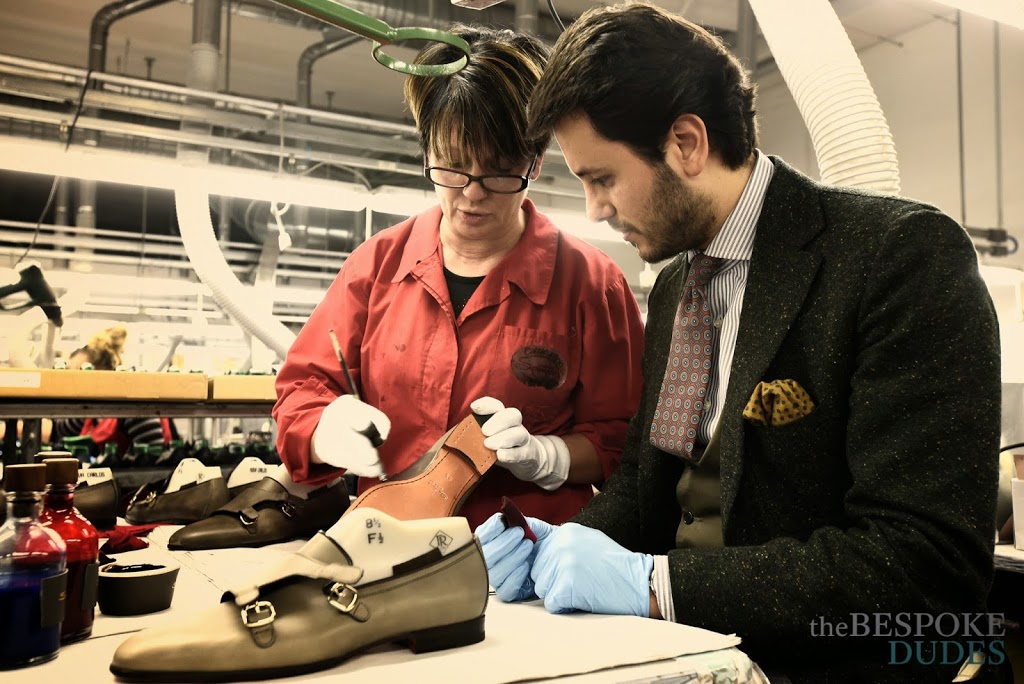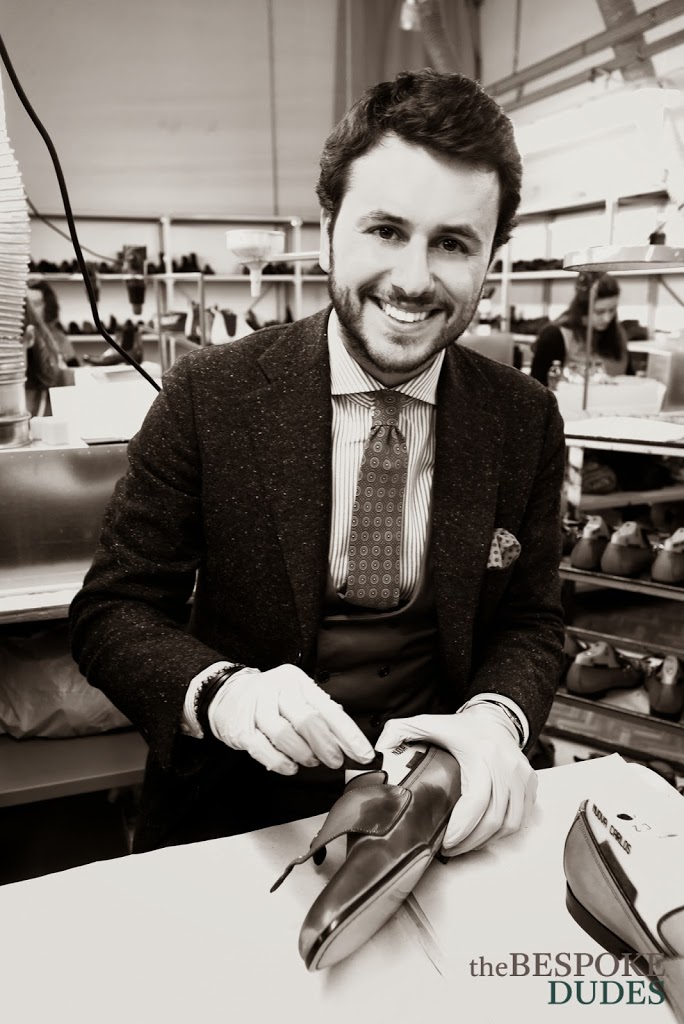The article - L'articolo
Corridonia, Marche. “Ours is a family business with an annual growth rate in double figures” says Roberto Martinelli, Head of Marketing for Santoni, when we meet in the recently refurbished headquarters. The building has a decidedly international flavour, with particular attention to the environment, both in the choice of building materials, and the use of alternative energy. So where is their added value? They chose quality over quantity. And this is not just another empty advertising slogan. Santoni's business began in the 1970s. The tendency at that time in the shoe making sector was to relocate the production stages that required less know-how, to produce high numbers without worrying too much about the quality. Andrea Santoni, the founder, realising that he was at a disadvantage if it came to trying to outproduce the competition, decided to gather together the last remaining local craftsmen who still knew how to make a pair of shoes by hand. It is precisely this fusion of industry and craft that strikes you here, and this is what guarantees its continued success. This is a happy exception to the classic trade off, where high numbers are inevitably linked to low quality.
Rosa is in charge of the stitching section, she is Andrea Santoni's wife and mother to Giuseppe who is now the sole president of the business. "Her's is the most precise section, the women who work with her have grown with her in the company" - I am told by Gloria Biribei, Head of the Press Office, as she shows me around. There are about 500 employees, making almost 1300 pairs of shoes per day ready for distribution. A thing that struck me, among the loud noise found accompanying any industry, was the conveyor, a trolley pushed by hand to move pieces from one stage of production to the next. "There are no minimum numbers to produce here, like you find in larger industries" - they tell me - "and in the occasional lulls the time is spent resoling shoes, a free service offered to customers." But the crowning glory of these shoes made in the Marche, is their hand colouring with cloth and brush. Most of the leather that they buy is crust, in a natural state, ready to be treated by specialised artisans, who carefully paint the leather as though it were a blank canvas, producing unique shades for every pair of shoes. The cordovan that comes from the American producers, Horween, for example, requires a lengthy process, and from one hide only one pair of shoes is produced. Another particular feature of these shoes is the increna stitching, where the sole is cut along the side, stitched internally and then closed to hide the stitching. When the Goodyear technique is used, the welt, uppers and insole are stitched together and the hemp thread used is treated with pitch and bee's wax by a master craftsman who uses a metal tool to ensure the correct twist in the thread, a sight well worth seeing. The unique features don't stop there, Santoni also has an expert last maker, producing beechwood lasts in close collaboration with the styling team, and a leather cutting shop for insoles which means that new models can be tried out much faster. This paragon of Italian craft also extends to watch straps. This came through a collaboration with the Swiss company IWC, using prized leathers, coloured by hand and applying particular techniques to ensure that the colour won't come off on clothes.
Bespoke hugs,Fabio
_______________
Corridonia, Marche. “La nostra è un’azienda familiare italiana che cresce ogni anno a due cifre” – esordisce così Roberto Martinelli, responsabile marketing Santoni, mentre mi accoglie nella sede rinnovata pochi anni fa. Una sede green, dal gusto squisitamente internazionale e che guarda all’ambiente, dalla scelta dei materiali di costruzione, alle fonti alternative di energia. Il loro valore aggiunto? Aver preferito la qualità alla quantità - e non è l’ennesimo vuoto slogan pubblicitario. La storia di Santoni, infatti, ha inizio negli anni ’70, quando il trend nel settore della calzatura italiana registrava una consistente delocalizzazione di fasi produttive che non richiedevano un eccessivo know-how, per poter produrre quantitativi ingenti con buona pace della qualità. Andrea Santoni, il fondatore, consapevole che la lotta sui numeri l’avrebbe visto in posizione di svantaggio, chiama a raccolta quei pochi ultimi artigiani locali ancora capaci di realizzare una calzatura interamente a mano. Ed è proprio l’incredibile fusione di industria e artigianato che colpisce in questa realtà produttiva e che ne sta decretando il continuo successo: un felice tilt del classico trade off che vede gli alti volumi necessariamente associati ad una bassa qualità.
A capo del reparto orlatura c’è la signora Rosa, moglie di Andrea Santoni e madre di Giuseppe, oggi unico presidente. “Il suo è il reparto più puntuale, le sue collaboratrici sono cresciute con lei all’interno dell’azienda” mi spiega Gloria Biribei, responsabile ufficio stampa, mostrandomi la produzione. Circa 500 addetti, per un totale che sfiora le 1300 paia di scarpe al giorno pronte per essere distribuite. E tra i rumori forti, tipici dell’industria, colpisce la manovia, un carrello spinto ancora a mano, per passare il prodotto da una fase all’altra del ciclo produttivo. “Qui non abbiamo quantitativi minimi di produzione come nella grande industria” – mi raccontano, “nei brevi tempi morti tra una fase e l’altra gli artigiani si dedicano alla risuolatura, servizio che offriamo gratuitamente ai nostri clienti”. Ma il vero fiore all’occhiello di questa realtà made in Marche è la coloritura a mano a suon di panno e pennello: gran parte dei pellami che comprano, infatti, sono in crust - al naturale – per essere lavorati da artigiani specializzati, che con perizia di pittori dipingono queste pelli come fossero tele bianche ottenendo sfumature sempre diverse da scarpa a scarpa. Il cordovan dell’americana Horween, ad esempio, richiede una lunga lavorazione e da un animale si ricava un solo paio di scarpe.
Particolare, inoltre, è la loro cucitura “increna”: la suola in cuoio viene tagliata in sezione, cucita nella parte interna e richiusa per nascondere la cucitura. Nella lavorazione di tipo Goodyear (orizzontale) fatta a mano - che unisce guardolo, tomaia e suoletta - il filo di canapa utilizzato è preparato con pece e cera d’api da un maestro artigiano che usa un bilanciere per assicurare la torsione giusta del filo - uno spettacolo da non perdere. Le singolarità non finiscono qui, perché la Santoni al suo interno può contare anche su un esperto produttore di forme in faggio - che lavora a stretto contatto con gli stilisti - e su una tranceria del cuoio per le suole interne, che assicura maggiore rapidità in fase di progettazione di nuovi modelli. E il tripudio di artigianalità italiana si estende anche ai cinturini per orologi, nati dalla collaborazione con l’elvetica IWC: pregiati pellami colorati a mano con tecniche specifiche, affinché non scoloriscano a contatto con gli indumenti.
Refiend hides - pellami pregiati
In the skins laboratory - Nel laboratorio pelli
Hand colouring the soles - Colorazione a mano delle suole
Upper and last, machine-made - Lavorazione di forma e tomaia a macchina
Working by hand on the Upper and the last - Lavorazione a mano di tomaia e forma di legno
Upper, insole and welt stitched by hand - Tomaia, suoletta e guardolo cuciti a mano
The tool to ensure the correct twist in the thread - Il bilanciere per la torsione del filo di canapa
Preparing the thread with pitch and bee's wax - Preparazione del filo con pece e cera d'api
Hand colouring of the uppers - Colorazione a mano della tomaia
Craftsman Dude
Ms. Gloria Biribei The leather cutting shop for insoles - La tranceria del cuoi interna all'azienda
Plastic lasts - Forme in plastica
Hand-coloured watch straps - Cinturini colorati a mano
With Mr Giuseppe Santoni
If you like what we are doing here, please consider following TBD onFacebook - Instagram - Tumblr - Twitter
Bespoke Hugs, Fabio
Ph: Enrico Magri








